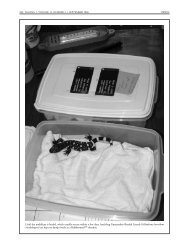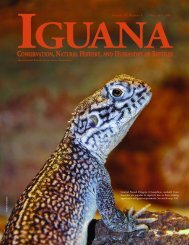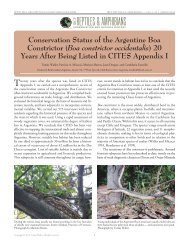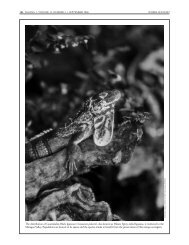Spiny-tailed Iguanas (Ctenosaura similis) in Venezuela
Spiny-tailed Iguanas (Ctenosaura similis) in Venezuela
Spiny-tailed Iguanas (Ctenosaura similis) in Venezuela
You also want an ePaper? Increase the reach of your titles
YUMPU automatically turns print PDFs into web optimized ePapers that Google loves.
JOHN S. PARMERLEE, JR.<br />
ROBERT POWELL<br />
DOMINICAN RACERS<br />
tern was recorded <strong>in</strong> photographs) had 33 and 52 dist<strong>in</strong>ct dorsolateral<br />
light patches, with darker pattern elements blend<strong>in</strong>g<br />
posteriorly. The largest of the three juveniles (290 mm SVL) had<br />
50 dist<strong>in</strong>ct pale dorsolateral light patches and the darker dorsal<br />
saddles were discont<strong>in</strong>uous near midbody, where 3–4 pale<br />
blotches extended middorsally through the saddle pattern.<br />
Posteriorly, the darker elements condensed <strong>in</strong>to a middorsal<br />
stripe, and virtually all <strong>in</strong>dications of the anterior pattern of saddles<br />
and patches were lost.<br />
When juveniles are compared with larger adults and<br />
subadults, the head pattern may be reta<strong>in</strong>ed essentially<br />
unchanged <strong>in</strong> some <strong>in</strong>dividuals or the tops of heads may become<br />
<strong>in</strong>creas<strong>in</strong>gly dark to the extent that the dist<strong>in</strong>ct juvenile ocular<br />
l<strong>in</strong>es are subsumed <strong>in</strong>to the uniformly dark dorsal and lateral<br />
head coloration. The light labial l<strong>in</strong>e is variously <strong>in</strong>vaded by<br />
darker pigment. In larger snakes that reta<strong>in</strong> some vague semblance<br />
of the juvenile pattern, the l<strong>in</strong>e may extend posteriorly<br />
onto the body. The darker elements of the body pattern expand,<br />
often become darker, and outl<strong>in</strong>es become <strong>in</strong>creas<strong>in</strong>gly <strong>in</strong>dist<strong>in</strong>ct,<br />
result<strong>in</strong>g <strong>in</strong> what appears to be a dark ground color with<br />
a series of variously def<strong>in</strong>ed white, cream, or yellowish lateral<br />
patches that vary <strong>in</strong> number and <strong>in</strong> how far posteriorly they<br />
extend onto the body. Parker (1933) described the adult pattern<br />
as “… posterior part of the body is almost entirely black, but<br />
anteriorly the dorsal stripe is broken up <strong>in</strong>to a series of large oval<br />
spots narrowly separated from one another; the light <strong>in</strong>terspaces<br />
IGUANA • VOLUME 15, NUMBER 3 • SEPTEMBER 2008 159<br />
An adult Dom<strong>in</strong>ican Racer with an abundistic pattern <strong>in</strong> which the dark pattern elements have expanded, with only a few light patches rema<strong>in</strong><strong>in</strong>g<br />
of the juvenile ground color.<br />
An adult Dom<strong>in</strong>ican Racer show<strong>in</strong>g the white labial l<strong>in</strong>e extend<strong>in</strong>g<br />
onto the body.<br />
may be fused on the sides of the neck to form a fairly dist<strong>in</strong>ct<br />
light stripe.” Schwartz and Henderson (1991) described it as<br />
“anteriorly large white to tan blotches on brown to black<br />
ground, sometimes alternat<strong>in</strong>g to form lateral zigzag, posterior<br />
solid black.” We observed adult “ground colors” rang<strong>in</strong>g from<br />
dark taupe through milk chocolate to very dark brown, dark<br />
slate gray, and jet black. “Blotches” of adults ranged from a few<br />
lateral light spots restricted to the anteriormost portion of the<br />
body to series of patches extend<strong>in</strong>g to midbody and, <strong>in</strong> a few<br />
<strong>in</strong>dividuals, the full extent of the body. The ch<strong>in</strong>, throat, and<br />
anterior portion of the venter rema<strong>in</strong> light, but variously stippled.<br />
Stippl<strong>in</strong>g becomes <strong>in</strong>creas<strong>in</strong>gly prom<strong>in</strong>ent posteriorly. The<br />
posterior ventrals and subcaudals are uniformly dark brown or<br />
slate gray. The transition from stippl<strong>in</strong>g to uniform dark color<br />
may occur as early as one-fourth the length of the body to well<br />
beyond midbody. The apparently ontogenetic changes <strong>in</strong> pattern<br />
are suggestive of progressive but variable abundism (=<br />
pseudomelanism).<br />
Acknowledgements<br />
We thank our mentors, Bob Henderson (Milwaukee Public<br />
Museum) and Robert Powell (Avila University), for guidance<br />
and support. They and John S. Parmerlee, Jr. made <strong>in</strong>valuable<br />
comments on earlier drafts of this manuscript. We thank Adam<br />
Mitchell, Ruthie Carter, and Seth Rudman for their help <strong>in</strong> the<br />
field. Mr. Arl<strong>in</strong>gton James, Forest Officer, Forestry, Wildlife, and<br />
Parks Division, M<strong>in</strong>istry of Agriculture & the Environment,<br />
Commonwealth of Dom<strong>in</strong>ica, was <strong>in</strong>strumental <strong>in</strong> issu<strong>in</strong>g permits<br />
to conduct research <strong>in</strong> Dom<strong>in</strong>ica and facilitated our efforts<br />
<strong>in</strong> myriad ways. Fieldwork was funded by a grant from the<br />
National Science Foundation (USA) to Robert Powell (DBI-<br />
0242589).<br />
Literature Cited<br />
Parker, H.W. 1933. Some amphibians and reptiles from the Lesser Antilles.<br />
Annals and Magaz<strong>in</strong>e of Natural History 10:151–158.<br />
Schwartz, A. and R.W. Henderson. 1991. Amphibians and Reptiles of the West<br />
Indies: Descriptions, Distributions, and Natural History. University of<br />
Florida Press, Ga<strong>in</strong>esville.








